story and photos by Michelle Sutton
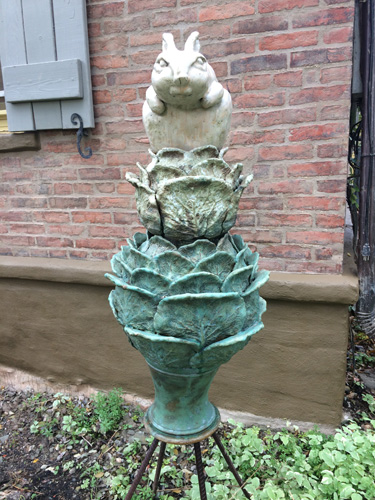
The rabbit-and-cabbage finial. Finials can pull together rebar to make a support for climbing vegetables and flowering vines.

Birds don’t seem to mind dwelling in this cat’s belly.

Mary Lynn and Bob Good. Photo by Hilary Argentieri Photography
Nearly twenty years ago, native Chicagoans Mary Lynn and Robert Good discovered the Finger Lakes region of New York State on a return trip from NYC. The charm and natural beauty of the area kept them coming back for more adventures and explorations. The Goods are artists, history buffs, and historic home restorers—they restored three Victorian houses in Chicago and have always lived in homes of historic significance.
After Mary Lynn’s parents passed on, she and Bob were ready for a change. On a trip to the Southern Tier in 2002, they happened by accident on the William Goff House (1830) in Howard, near Bath. “It was everything we were looking for,” Mary Lynn says. “It’s one of the oldest, most historic houses in Steuben County. It’s a stone-and-brick, super-solid house with original everything—historic features intact. We were thrilled.”
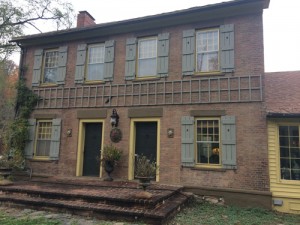
Front of the William Goff House
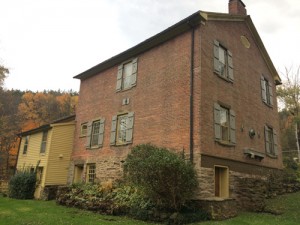
Back of the William Goff House
William Goff purchased several hundred acres of land in 1812. He built Goff House by milling timber from his forest and making bricks from the white clay that runs in veins along Goff Creek. Goff was a stonemason who found and cut all the stone himself for lintels, thresholds, and foundations. He created an early 19th-century hub around him, operating grist, carding, and fulling mills, an inn, a post office, a distillery, and a tailor shop on the stagecoach line.
At the same time that the Goods threw themselves into fixing up Goff House, Mary Lynn started pursuing her longtime (since 1985) interest in pottery more seriously, taking classes at 171 Cedar Arts Center in Corning. “I would volunteer to make glazes so I could learn how to do it. Anything they wanted done, I would do it for free—to learn,” she says.
• • •
For the Goods, 2006 was an auspicious year. They decided to open for retail sales at the studio of Goff Creek Pottery, and they went to Connecticut for their first flower show, where their flower pots, birdhouses, and sculptures sold like crazy. Each piece was unique, as is still true today. All of their work is created with a specially formulated red clay that can be fired to 2300 degrees in the kiln, hot enough for the clay to vitrify. The vitrifying process closes the pore spaces, which means that water cannot penetrate into pores like it does in terra cotta, where it would normally freeze and cause the structure to crack. “Basically, vitrifying turns the clay back into stone,” Mary Lynn says.
Closed pores is also the reason why the sculptures can be so heavy—some of the larger pieces are 300 pounds or more. It’s a good thing all Goff Creek Pottery pieces are frostproof and can stay outside all winter; that’s one of the hallmarks of the Goods’ work.

Garden sculptures with ornate finials, and a low birdbath with an everpresent toad.
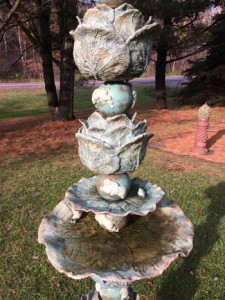
A section of a rabbit-and-cabbage themed totem that includes a birdbath.
For eight years Bob and Mary Lynn took pieces—even the very large ones—to major garden shows around the country, including those in Rochester, Buffalo, Philly, Chicago, and Atlanta. “We loved doing the shows but we’ve tapered way back, in part because of the stress of moving such heavy pieces,” Mary Lynn says.
It’s also because Mary Lynn, who loves science as much as art, went back to school and became an ICU nurse. “I’d been thinking about it for a long time,” she says. “I’m equal parts right brain and left brain, and I’m happiest having both science and art in my life.” (Her first degree was in design and commercial art.) Bob is busy with Goff Creek Pottery, maintaining the house and larger physical complex, and writing his childhood memoirs.
Goff Creek Pottery ships anywhere in the U.S.— including heavy pieces. As you can imagine, the shipping for those is exorbitantly expensive, but Bob has also hand-delivered larger shipments, such as a suite of sculptures for a retirement community in Phoenix known for its huge art collection. “We saved them money on shipping, and they were very pleased,” Mary Lynn says.

The lawn chess toads show great team unity.
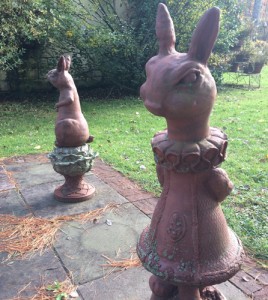
Rabbit lawn chess figures
Those heavy pieces were a longtime dream of Mary Lynn’s. “I’d always been drawn to English gardens [including follies] and had this idea of making a big lawn chess set of rabbits v. toads. Bob and I mean it as a nod to gardeners by having rabbits—which destroy the garden but everyone loves because they’re so cute—and toads—which are ugly but so beneficial for the garden—spar with one another.” A handful of clients have purchased entire sets, while many others buy one larger-than-life toad or rabbit.
A customer and friend in Louisville, Kentucky bought several of the chess pieces and then requested an Alice in Wonderland themed set of sculptures. “We made her an Alice, a Queen of Hearts, Tweedle Dee and Tweedle Dum, the Mad Hatter, the Dodo, the King, the Knave, the Red Queen, a big tree with the Cheshire Cat in it … she has 20 different pieces in all,” Mary Lynn says.
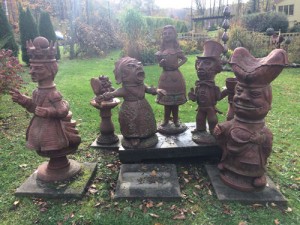
A lively subset of Mary Lynn’s Alice in Wonderland sculptures. Each one took two weeks to sculpt.
For specially requested sets or pieces, or for sculptures that are needed for a deadline, Mary Lynn makes two of everything to hedge against occasional accidents and misfires. There are three stages to the process for pieces large and small—the making, the drying, and the firing. For instance, sculpting each detailed piece in the Alice in the Wonderland set takes about two weeks, then the piece is dried in the kiln for a month or longer, then it takes three to four days to fire it. Because the whole process can take several months, Bob and Mary Lynn have to be good planners so that clients are sure to receive their pieces on time.
• • •

Cat finials to pull together rebar supports for morning glory, climbing beans, and more.
Animals are a big part of Bob and Mary Lynn’s life together and the primary inspiration and subject matter for their pottery. They found their very affectionate cat Floyd when they heard a teeny kitten yowling in the nearby woods. Floyd loves water, loves the rain, and sits in the sink and waits for Bob or Mary Lynn to turn on the water so he can go in. They have a parti poodle (“parti” refers to white with patches of color, as opposed to solid color) named Agnes who they brought home as a puppy. Floyd and Agnes are buddies who “look like MMA fighters when they wrestle—and Floyd’s always the instigator, whacking Agnes in the face,” Mary Lynn says.
The Goods are known for their toad houses. “Toads use them to hide from the sun and the more toads you have, the fewer snails and slugs you have,” Mary Lynn says. One customer asked Mary Lynn to make a toad house in the shape of a rabbit. From there, the rabbit theme took off and at Goff Creek you see bunnies on plaques, tiles, finials, birdhouses, birdbaths—and most dramatically, in the larger-than-life chess pieces.

Serving plate

Ceramic bunny flasks
The rabbits of Goff Creek Pottery look at you with some classic lagomorph attitude. Mary Lynn says, “These are real rabbits who, when they’re eating your garden, look at you like, ‘Hey I’m eating here, don’t bother me!’ Look at Victorian woodblock prints of animals—all the animals look like they were having a really bad day,” she says, laughing.
Before Floyd appeared on the scene five years ago, there was an invasion of rabbits one summer. Mary Lynn says, “I’m not kidding you, everywhere you looked were clusters of little rabbit families all over the yard. We had one very young bunny who would take his dirt baths by the front door and let me pet his stomach.”
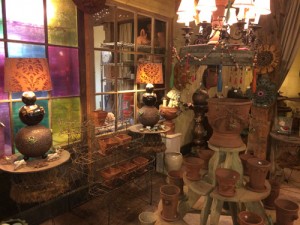
Inside the Goff Creek studio and retail space

Inside the Goff Creek studio and retail space
The Goods would love to have chickens but fear that the foxes who regularly sail right through the property could crash that party. Deer are abundant in the woods but so far, mercifully, have left the extensive Goff Creek display gardens alone.
Goff Creek Pottery, open to individuals and groups by appointment, is a delightful place to spend a couple of hours. “When I was a kid, my family would go to this one garden center, Amling’s Flowerland, in the suburbs of Chicago,” Mary Lynn says. “My favorite thing was looking for the hidden sculptures among the plantings—I loved to be surprised! That was something that influenced me a great deal. I like to give that experience of surprise and delight to other people.”
Michelle Sutton (michellejudysutton.com) is a horticulturist, writer, and editor living in New Paltz, New York.
Views: 22




